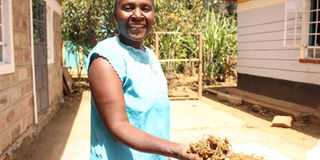Go against the grain and grow some millet

Alice Moimett, a finger millet farmer in her farm in Outspan, Eldoret. The crop is rarely attacked by diseases. PHOTO | STANLEY KIMUGE | NATION MEDIA GROUP
What you need to know:
- It takes five to seven days before the seeds germinate and after three weeks she starts to remove weeds.
- The crop is rarely attacked by diseases, save when the conditions are humid or during rainy season. Birds also can be a menace but that is something farmers can deal with.
- One can also apply CAN to top-dress after six weeks after planting time and also six weeks to harvesting time.
- In the past, the challenge was the issue of weeds. But with the availablity of various herbicides such as 2, 4-D weed killer and Buctril, farmers are able to increase the number of acreage.
Acres and acres maize plantations line up the Eldoret-Iten Road. The green plants shivering rhythmically in the light morning breeze is a sight to behold. Maize, however, is not on the agenda today.
We are headed to Moiben, a fast-growing trading centre in Uasin Gishu County, from where we will make our way to Sosiyo village in Meibeki.
We are here to see Anne Murei, one of the few farmers in the region who is going against the grain: growing finger millet.
We find her busy tending to the crop placed under two acres. Anne says she started growing finger millet over five years ago to avoid growing maize, which is farmed by nearly everyone.
To plant the crop that takes five months to mature, Anne harrows the soil then mixes it with organic fertiliser before sowing the seeds.
“I make rows that are 60cm apart and then plant 3kg of seeds per acre, applying four 90kg bag of fertiliser on the portion,” she says, adding one must cover the seeds with little soil for them to germinate.
She buys one kilogramme bag of the seeds for Sh500 in retail shops in Eldoret town.
It takes five to seven days before the seeds germinate and after three weeks she starts to remove weeds.
“I continuously weed after every two weeks, which means the crop is labour intensive and perhaps this is why most people shy away from it,” says the farmer.
Last season she harvested 10 bags of millet, eight of which she sold to a nearby boarding school at Sh6,000 per bag.
“When I harvest, I keep the produce in sacks for three days so that the high temperatures enable the colour to change to red or black/brown from green. I then dry in the sun for three days before threshing.”
RESISTANT TO DISEASES
She says one can also store the produce directly after sun drying without threshing.
After the eye-opening visit at Anne’s farm, we head Outspan to on Eldoret-Nakuru highway where we meet Alice Moimet weeding her crop.
Alice intercrops maize with finger millet with the latter providing a shed to help retain moisture in the soil. The practice also helps her utilise her land well since the maize crop does not compete with the millet.
“I have been growing finger millet for years. The grain has good prices because I sell a 90kg bag at between Sh8,000 and Sh12,000.”
The farmer sells mainly her produce to schools and traders in the Eldoret market.
Pauline Koiser, a county agricultural officer in Uasin Gishu, says finger millet is a gem that is yet to embraced by farmers.
“The crop is rarely attacked by diseases, save when the conditions are humid or during rainy season. Birds also can be a menace but that is something farmers can deal with.”
Koiser says that with availability of herbicides, the cultivation of the crop is also economical.
“In the past, the challenge was the issue of weeds. But with the availablity of various herbicides such as 2, 4-D weed killer and Buctril, farmers are able to increase the number of acreage.”
She recommends that one should start using herbicides when the unwanted plants have attained three to five leaf stage.
“One can also apply CAN to top-dress after six weeks after planting time and also six weeks to harvesting time,” says Koiser.
***
Uses
- Porridge
- Bread
- Beverages: Beer and distiled liquor. Its amylase enzymes readily convert starch to sugar
- Fodder: It makes good fodder better than wheat or sorghum. It contains up to 61 per cent digestible nutrients
- Popped products: finger millet can be popped. It is widely enjoyed in this tasty form in India





